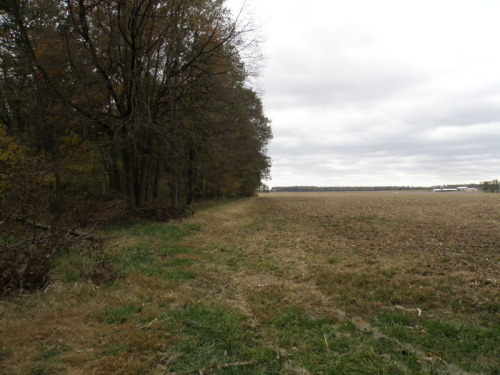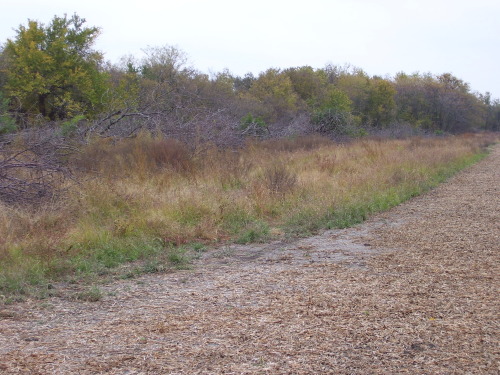Woodland Edge Feathering
By Rob Chapman
Attracting wildlife is a popular goal for many landowners in Indiana, whether for hunting, wildlife watching, or the comfort of knowing that their property is desirable to animals. Establishing food plots, planting wildflowers and native grasses, prescribed burning, and constructing shallow ponds or wetlands are practices that many landowners utilize to increase wildlife habitat. But what about the edges between fields and woodlands? This area can be the most overlooked opportunity for wildlife habitat improvement, and one that can benefit many species of wildlife that are rapidly declining in abundance.
Natural resources professionals describe an edge as a place where two distinctly different vegetation communities, or habitat types, come together. If you were to look at any state in the Midwest using Google Maps, you would notice a landscape full of fields and woodlands adjacent to each other. These edges also existed 50-100 years ago, except they looked considerably different than they do today. In the early to mid-1900s, agricultural fields and pastures were smaller and were separated by brushy areas that consisted of native grasses, annual plants, wildflowers, briars, and shrubs. The woodlands were often bordered by shrubby habitat as well, providing a gradual transition from fields to woodlands. Many species of wildlife thrived in these brushy environments, including species such as Northern Bobwhites, Indigo Buntings, Eastern Bluebirds, and Eastern Cottontails. Aldo Leopold, the father of Wildlife Management, called this increase in wildlife between fields and woodlands the “edge effect”. As farming became increasingly more mechanized and efficient, field sizes grew larger and brushy field borders that housed wildlife began to disappear. Many of the young trees found in woodlots grew taller and their canopies quickly shaded the ground, further reducing the amount of brushy habitats on the landscape.
Today, most field/woodland edges have no gradual transition of brushy habitat. The edge is marked by a sudden wall of tall, mature trees and is what we call an abrupt edge. Abrupt field/woodland edges provide very little habitat for wildlife. In fact, predation rates often increase in areas with abrupt edges as they become attractive to predator species and little to no escape cover is available for prey species. Abrupt edges also provide little to no breeding and brooding habitat for species like quail and rabbits. Decreased breeding habitat and no escape cover from predators are the primary causes of decline for quail and rabbits. Fortunately, there is something you can do to provide the brushy, weedy, habitat required by quail, rabbits, and similar wildlife species on your property.
Edge feathering is the practice of creating and maintaining a transitional area of brushy habitat between fields and woodlands. The transition should ideally begin with grasses and forbs (annual plants and wildflowers) then move through briars and shrubs to small trees and eventually to the larger trees of the woodland. This transitional area will provide nesting cover, protection from weather and predators, and food, such as berries, nuts and seeds, browse, and insects. It would be ideal to feather the entire length of all edges at once, but that is likely unrealistic to accomplish for most landowners. So begin in 100-foot lengths, working as many 100-foot lengths as you have time in one year. The next step is to identify a belt of 30-150 feet wide along the field/woodland edge, depending on topography and other land management objectives. Divide the belt into three zones, as you will be applying a different practice in each of the three zones. After you have your length and width determined, it is time to determine how you will install the feathered edge, which can be accomplished in three primary ways.
Thinning is a good option for landowners not wanting to give up area from the field to establish a feathered edge. The idea here is to work into the woodland, thinning trees. Thin about 75% of the canopy trees in zone 1 closest to the edge, 50% of the canopy trees in zone 2, and 25% of the trees in zone 3. Remove trees that are unhealthy, undesirable, or of limited value to wildlife while leaving trees that will likely produce favorable wildlife habitat. Examples of trees to remove would be elms, maples, exotics, and most hickories. Leaving a few hickories is desirable, especially for the squirrels. Concentrate on leaving oak trees standing, especially the white oaks. Consider leaving a few soft mast trees, such as hackberry and cherry, and definitely do not remove shrubby species, such as dogwoods, hazelnuts, and plum. Cut trees can be left where they fall, piled into loose brush piles, or removed for firewood. If you are lucky enough to have a pallet mill close by, you may be able to sell some of the trees for use as pallet stock.
Planting is a good option for landowners not wanting to work into the woodland and do not mind working into the field. Native grasses (such as little bluestem, indiangrass, switchgrass, and big bluestem) and wildflowers should be planted in zone 1. Low growing shrubs with dense canopies (such as shrub dogwoods, American plum, and hazelnut) should be planted in zone 2. Plant hard and soft mast trees, especially oaks, cherry, and hackberry, in zone 3 along the woods.
If you are able to give up a little area in both the field and the woodland, then a combination of the above would be desirable. For two zones in the field and one zone in the woodland, plant zone 1 with native grasses and wildflowers, plant shrubs in zone 2, and thin 25% of the overstory trees in zone three. For one zone in the field and two zones in the woodland, plant native grasses and wildflowers in zone 1, thin 50-75% of the trees in zone 2, and thin 25-50% of the trees in zone 3.
After you begin installing the feathered edge, you realize that this is pretty hard work and begin to wonder if the fruits of your labor will pay off. Just remember to be patient and keep reminding yourself of the phrase “If you build it, they will come.” from the movie Field of Dreams. Within four years, a landowner in Iowa increased the number of coveys of quail from one to five after installing feathered edges. The Bradford Research Farm of the University of Missouri installed feathered edges and native grass field borders which resulted in an increase from 2 to 26 coveys in only three years. Furthermore, research conducted at Mississippi State University has demonstrated that conservation buffers can increase net returns of corn in adjacent crop fields by increasing yields of the rows adjacent to the buffers. Financial assistance for installing feathered edges through programs such as the NRCS Wildlife Habitat Improvement Program (WHIP) could be an option for many landowners. If you have any questions about edge feathering for wildlife, please feel free to contact me at 812-458-6978 or rnchapman@purdue.edu. Contact your District Wildlife Biologist or District Forester for technical assistance and information on cost share options and availability.
Robert Chapman is an extension specialist in the Department of Forestry and Natural Resources at Purdue University.


